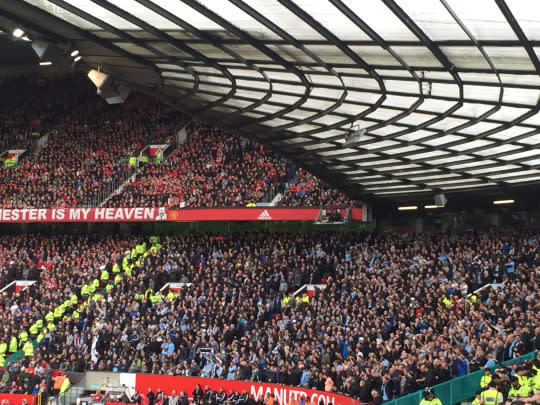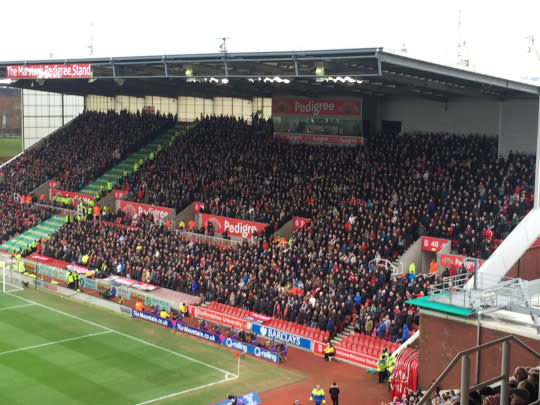Time For Safe Standing?
Andy Mitten ask if it is time for safe standing areas to be brought in at football grounds and how it would work?

It was a poor game, but the three Manchester United players had a great time in the away end at Anfield on Sunday. “Get in boys!” tweeted Michael Carrick. ‘Waited a long time to do an away game properly. Nearly thrown down 3 rows when we scored.”
Carrick, Marcos Rojo and Phil Jones stood among 2,600 fans in the Anfield Road end. They wore hats and covered their faces outside Anfield, a place where United players aren’t the most popular, but it was positive to see them among normal fans, where, as always, they stood in a seated area.
“In among those United fans at Anfield, I expect there were one or two who would have preferred to sit down,” explains Jon Darch, who runs the Safe Standing Roadshow promoting rail seats.
“They couldn’t because everyone around them was standing. That’s another problem which safe standing would sort out. When you were booking your away tickets, you would be asked if you wanted to stand or sit.
“Had there been rail seats at Anfield, then fans including Carrick would have been safer with the late winning goal. They could have celebrated until their hearts’ content, but they would have not fallen over the seat in front. Standing behind a low backed seat is not incredibly dangerous, but can result in bruised shins or falling forward over rows as Carrick did.”
United fans stand at every away game and the authorities don’t like it, meaning ticket allocations get cut at grounds like Anfield. It means fans on the last two rows of a stand originally designed for standing and then converted to seating in 1982 can’t see properly. It’s far from ideal.
Away fans of many clubs stand in seated areas. Burnley fan Alistair Campbell this week tweeted a picture of the Clarets’ away end at Griffin Park, Brentford, with “Safe standing. Already happening so why can’t it happen everywhere?
“A big part of the pleasure came from Burnley fans having a choice about whether to sit or stand to enjoy it all,” wrote Campbell, “and I am pretty sure the ones who stood enjoyed it more than the ones who sat.”

Burnley fans stood at Old Trafford last season, like most away fans then. Even in the home sections, fans in J stand throughout matches, with stewards turning a blind eye.
In the Stretford End, fans also stand for large periods of matches. Occasionally, stewards will ask them to sit down, a thankless task as fans will then stand up during the next exciting moment of play, which, admittedly, can be a while at Old Trafford these days.
Darch has long pushed for safe standing. A Bristol City and Union Berlin fan who divides his time between Bristol and Berlin where Union play in a ground which is three quarters terracing, he’s led the safe standing road show around British grounds since 2012.
The spectre of safe standing – that is rail type seating as found in many German grounds which can be flicked to seats or can provide a barrier to lean on when fans stand - finds approval among British football fans. They’d welcome lower admission prices as more people can be housed in the same area.
In Germany, the ratio is up to two standing fans per seat. Being able to stand with their mates makes for a better atmosphere, with more fans in the same section.
In Scotland, Celtic have become the club to be given permission to trial safe standing areas and will install 2,600 rail seats from next season at Parkhead, a wedge shaped section on the lower tier used by the vocal and colourful Green Brigade.
Their antics don’t always find approval with their club, but on the whole Celtic appreciate the noise and colour they bring to games.
“The Celtic trial will make it much easier,” says Darch. “Politicians and journalists will be able to see how it works in Glasgow rather than having to go to Germany.”
Celtic, who listened to their fans, wanted to make their home even safer for those who stand anyway.

In Wales, Cardiff have a singing section where fans stand, though, strictly speaking, they’re not meant to. The Welsh Tories have called on the devolution of sports ground safety from Westminster to Cardiff, which, if granted would allow Welsh clubs to run a safe standing trial.
In England, it’s more complicated, though a government paper published in December mentions safe standing when there was no precedent to do so. It does say that that the government is not currently persuaded to move away from all seater stadia, adding that after the Hillsborough inquests have finished and depending on the success of the trial in Glasgow, they will re-assess the position.
Manchester United’s Ed Woodward told this writer two years again: “Standing is something we’ll look at (at Old Trafford). I can definitely see the appeal of the German model, Dortmund being the stand out model in that their ticket prices are very reasonable.”
United officials again saw how it worked at Wolfsburg in December, when United fans stood on a terrace for the under-19s game and then behind rail seats during the first-team game, but the Premier League have never formally discussed it with their 20 member clubs. Any change would need the approval of 14 clubs. The Premier League have also yet to consult fans in their annual survey.
The Hillsborough disaster is usually brought up when the subject of a return to standing at football is mooted. People like Darch are at pains to say that nobody wanted a return Kop like terraces with swaying masses stumbling around.
Safe standing is different, but Hillsborough is still, quite rightly, of immense significance to the subject, especially among non-football fans who can’t understand why people want to stand at games.
“Hillsborough was less about whether fans stood or sat, than how many people were crammed into the same limited space, and what quality of policing, stewarding and security existed to make sure the numbers matched the space,” wrote Campbell in his blog under a heading: ‘For heaven’s sake bring back standing at football – an issue no longer being decided by logic’.
The coroner at the Hillsborough inquests is due to start summing up next week. The jury is due to retire and consider the verdict at the end of February, with a verdict expected in March. Politicians may then be more inclined to get more involved in a push for safe standing.
Clubs certainly want a debate at least. When the Football league sent a letter to their 92 member club in 2014, 75% of the 92 replied ‘yes’ to the question: ‘Do you want us to go to government to ask for a debate on safe standing?”
Clubs should listen to their fans, but those planning new stadiums are mindful of safe standing. Spurs anticipate an increase of 1,800 in the capacity of their new South Stand if safe standing and such an increase is allowed.
Because they are building from scratch, they are able to build into the design the exit routes and concourse capacities required for a larger crowd.
The Premier League has been a huge domestic and international success. Most of the people who watch games don’t go to games and safe standing is not a key issue. But for the millions who do and who sell out football grounds every week, the ability to have a choice, to pay less and to improve an atmosphere which can sometimes be too sanitised, remains important.

